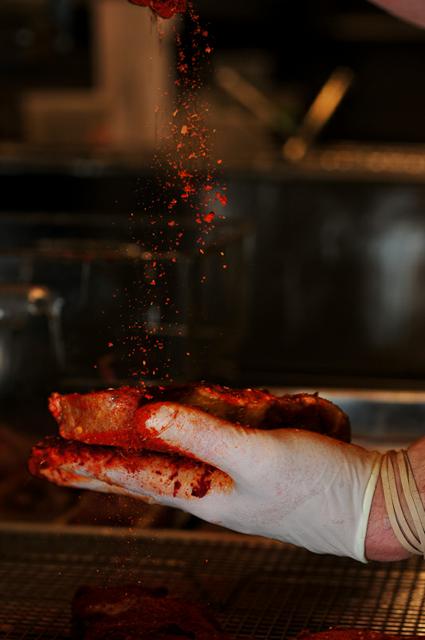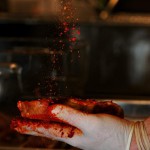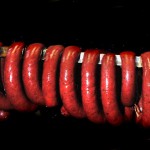- What a ham: Storm's chef, Owen McGlynn, sprinkles a mixture of salt, paprika and other spices on a cut of pork he'll turn into tasso ham. Photos by Bill Rhodes
- Chairman of the board: Jay Parrino of The Southern presides over some of his and Chris Saffles’ charcuterie work.
- The goods: A selection of charcuterie at The Southern, including pistachio mortadella, bresaola, merguez, salami cotto and a luganega sausage.
- Wurst works: The Chop Shop makes smoked meats and sausages in-house using meat butchered on the premises from whole animals.
Home for the holidays is a nice notion, but having family around for too long can get claustrophobic. Whether you want to round up the troops and head out or just make a solo escape, chances are good that you won't want to eat heavily before any of the inevitable big meals.
In talking to area chefs about good small-plate options, we decided to focus primarily on charcuterie. If you're not familiar with the word, you're most likely familiar with the concept. It's the culinary art of turning meat into terrines, galantines, confit, sausages, etc. in order to preserve them. In an effort to use every last bit of the animal, chefs all over are turning to smokers and other curing methods to turn castoffs into something useful — and delicious. But, don't think it's all about weird parts and pieces. For some, it's a matter of practicing and refining a craft, and for others, it's born out of a way to get creative with certain limiting factors. Here are a handful of places around Asheville where you can find someone making charcuterie.
Go South, young man
The Southern Kitchen and Bar is somewhat limited by building codes as the kitchen can’t be equipped with the traditional ventilation hood. Translation: no sautéing over an open flame, no grill and lots of making do with creative thinking. Chef Terri Roberts and crew manage to turn out some very good food using convection ovens, sous vide cookery, panini presses and a little smoker box.
Chris Saffles and Jay Parrino skirting technical limitations with old-fashioned know-how. The two cure an assortment of charcuterie that includes bresaola, sausages and salami. The Southern serves an ambitious meat board supplemented with a cheese selection that (sometimes) includes a buttermilk blue and a Grayson taleggio, plus housemade pickles, jams and a smattering of olives. A fantastic duck ham with a rind of meltingly rich fat is made by de-boning, rolling and tying the legs and breast, then packing the meat in a salt-and-sugar cure spiked with aromatics like shallots, garlic, rosemary, oregano and thyme. After a short curing time, it's served with a frisée-and-brie salad. "It's almost like making gravlax," Saffles says. "I just let it sit for three days like that, then I rinse it off and smoke it to an internal temp of about 130 to 135." Three days is no time compared to the pepperoni, which takes about two months to cure.
The crew also makes foccacia, pickles and is about to start making hamburger buns. “We're making pretty much everything in-house now," says Parrino. Many of the preparations are a challenge with the equipment they have (or more accurately, don’t have), but they make it work. "The fact that we don't have that stuff gives me more incentive to do more with the meat-and-cheese board," says Parrino. "There's more of a necessity to do things like that, so we can bring in interesting products," Saffles adds. "I don't have an open flame, so what's the point of bringing in duck? It forces you figure out other things that you can do with it."
And to good end, we hasten to add. The Southern Kitchen and Bar is located at 41 N. Lexington Ave. http://www.southernkitchenandbar.com, and will be open Christmas Eve, but not Christmas.
In the belly of the Storm
Storm Rhum Bar is working on perfecting the art of the cocktail-accompanying nosh. Besides great drinks like the Devil's Oasis (rum, passion-fruit, cayenne-infused honey, lime), the restaurant offers a number of small plates, along with full entrees. Particularly good for a bar snack is the three-cheese macaroni with jalapeños and bacon, served in a small or large portion. Chef Owen McGlynn, however, doesn't stop at pasta when it comes to smoked belly meat.
Especially intriguing is the lamb bacon, which McGlynn carves from the whole animal and smokes in-house. Storm’s charcuterie plate often features housemade tasso ham, and always includes various short-cure items, like patés. "They're constantly changing, but I usually have three different kinds," says McGlynn. He’s no stranger to making the best of what’s on the table; he regularly utilizes liver, hearts, chicken gizzards and pig heads that local farmers bring to him. It's a good way to make sure that nothing gets wasted, he says.
"The way I was taught, when you get the whole hog, you use the head to the tail, and this was before people were even getting into that style. But it's something that I enjoy doing; it's a passion." So much of a passion, in fact, that he cures salami in his spare time at home for his own use.
Part of what appeals to McGlynn about the art of charcuterie is the effort required to get it right — and getting it right is important. "It's sensitive. It's as much science as cooking — getting the molds right and the temperature." Right now, McGlynn's curing some lamb pancetta that should be ready some time in the early part of next year. Storm Rhum Bar is located at 125 S. Lexington Ave. http://www.stormrhumbar.com, and will be open for Christmas Eve, but not Christmas.
Table talk
It's a tiny bar that Table has, but it’s big enough to belly up to. Table has an extensive wine list, a selection of “tastes” that deserve a look and an array of larger-than-tastes-but smaller-than-entrees plates, including a selection of house-cured meats and artisanal cheeses.
Chef/owner Jacob Sessoms, chef Matthew Dawes and Jeremy Hardcastle always have some sort of long-cure charcuterie doing its thing in dedicated coolers. Frequent projects include traditional Italian salamis or the French-style saucisson sec. The crew is currently developing their version of country-style ham. Short-cure items made at Table include various patés and hot dogs and, while you can't sample the hot dogs on the charcuterie board, they do appear as corn dogs on the menu at Sessoms' other restaurant, Tod's Tasties on Montford Avenue.
The reasons that Table creates charcuterie are many, says Sessoms. "As cooks, it's kind of a logical progression," he says. “We don't want to do the same thing day in and day out, and it's kind of a challenge to go beyond the comfort realm. And obviously, it's trendy across the country now — it's part of the farm-to-table, whole animal consumption, nose-to-tail eating," he explains. And finally, "Not only was it born out of culinary tradition, it was born out of a way to save money," he says. And every restaurant owner likes to save a little money while still selling something delicious.
Sessoms and company hope to eventually build a kitchen exclusively for charcuterie retail and wholesale. "It would just take the time and energy to build the facility," he says.
At just over $10, Table's charcuterie board is an opportunity for guests to sample some of what the restaurant has to offer without committing to an entire meal. "For the general public, it’s a good way to come sit at the bar and have a cocktail and a meat board and see Table at an inexpensive rate," says Sessoms. Table is located at 48 College St. http://tableasheville.com and will be open Christmas Eve, but not Christmas.
Munching at the Junction
The Junction in the River Arts District makes for a great escape any time (though do note that the restaurant/bar will be closed both Christmas Eve and Christmas).
The Junction has fantastic seasonal cocktails and a menu that focuses on updated classics — chef Camp Boswell's favorite dish along this vein being the sweet tea-brined and fried Ashley Farms chicken served with caramelized onion gravy. Speaking of updated classics, Boswell runs various charcuterie items on the menu such as a cured and smoked pork belly, house sausages and other bites that require a shorter curing time.
With the upcoming changes to the Junction’s winter hours — no more lunch, but Saturday and Sunday brunch starting early next year — Boswell will have time to focus on more elaborate charcuterie items. He was first exposed to the art in earnest when he worked for Chris Hastings, the chef/owner of Hot & Hot Fish Club Birmingham, Ala. and a two-time James Beard Award finalist. "We had everything from duck prosciutto to pickled beef tongue, all sorts of different pickles, all kinds of smoked meat and sausages," Boswell says.
And why does he spend his time making such things? "For me, charcuterie is just interesting. It's such an old art form that basically evolved out of necessity," he says. "This was what people were using back before refrigeration existed; this was their method of preserving their meats and foods to make them last longer." Also, Boswell says, it's gratifying to utilize atypical cuts and prepare them in ways beyond sautéing, grilling and roasting. "It's just something new that a lot of people don't have experience with," he says.
That's part of the art of cooking, anyway; taking something with classic roots and making it new. 348 Depot St.,
225-3497.
— Send your food news and story ideas to food@mountainx.com.








Before you comment
The comments section is here to provide a platform for civil dialogue on the issues we face together as a local community. Xpress is committed to offering this platform for all voices, but when the tone of the discussion gets nasty or strays off topic, we believe many people choose not to participate. Xpress editors are determined to moderate comments to ensure a constructive interchange is maintained. All comments judged not to be in keeping with the spirit of civil discourse will be removed and repeat violators will be banned. See here for our terms of service. Thank you for being part of this effort to promote respectful discussion.